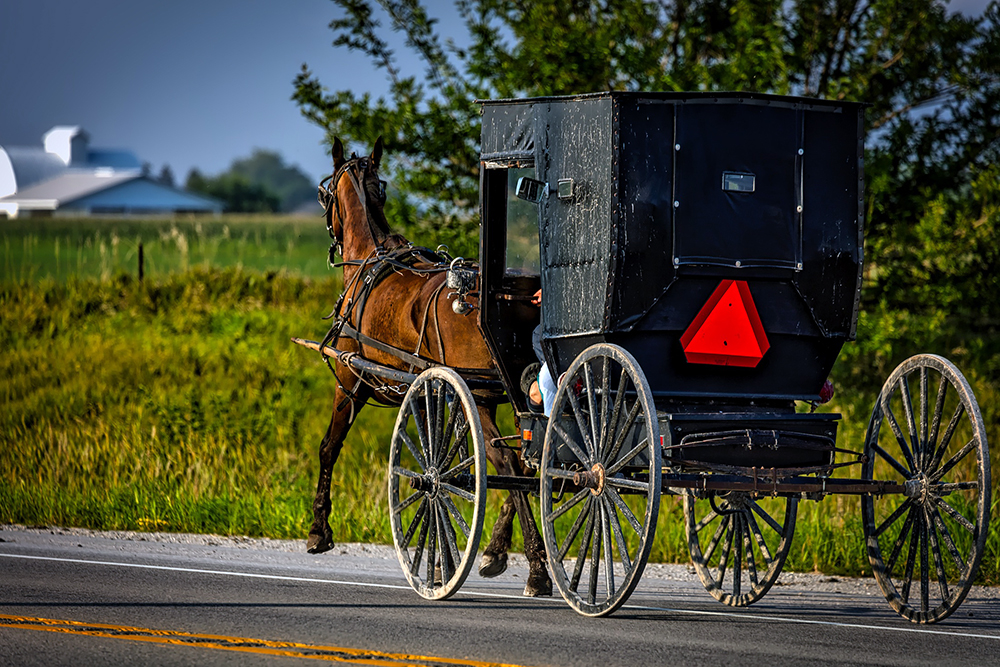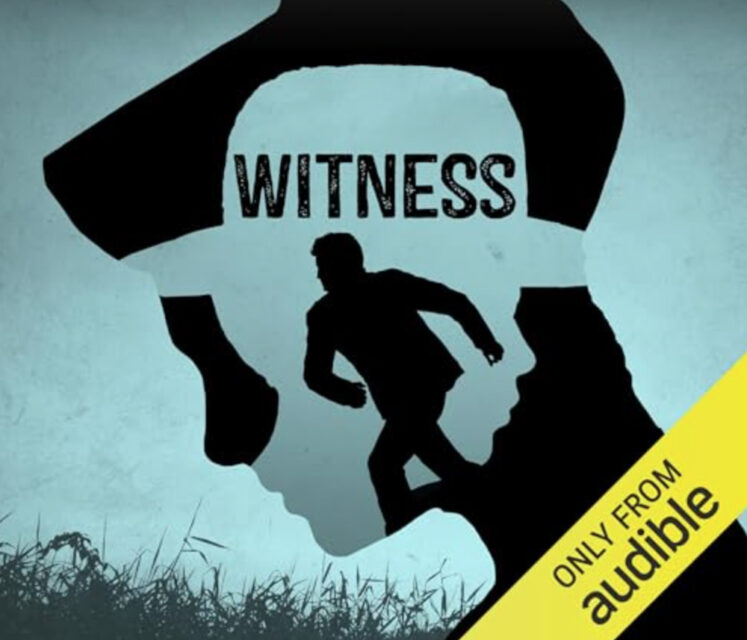(RNS) — The 1985 film “Witness” was a surprise hit — part cop thriller, part Amish romance, with a pair of stars in Harrison Ford and Kelly McGillis at the top of their game, a crackerjack script and a brilliant director in Peter Weir.
Despite a modest budget of $12 million and few expectations, the film earned more than $65 million at the box office and a host of Academy Award nominations and became a beloved classic, giving moviegoers worldwide a view into the life of the Amish. It was also a parable about America’s soul and what happens to true believers when the institutions and leaders they trusted fail them. Do they give up — or do they keep the faith?
Those questions are at the heart of a new adaptation of “Witness” as an audio drama for Audible Studios, which debuted just before the new year. The adaptation from award-winning podcast maker Gideon Media is a modern miracle of sorts — both true to the original film and something that feels brand-new.
The new adaptation got its start during the early days of the COVID-19 pandemic when Hollywood studios had shut down production. An official at Paramount Studios, which owns the rights to “Witness,” reached out to Sean Williams, a Gideon producer and writer, to see if they could work together.
“When the pandemic hit, basically every network in America shut down,” Williams said in a recent interview. “But then everyone found out that we could still make shows.”

Mac Rogers. (Courtesy photo)
Paramount gave Gideon a list of possible films to adapt, including “Roman Holiday” and “Witness.” Williams and his colleagues sent a list back. Among their top choices were the 1976 films “Marathon Man” and another film from 1985, “Clue.”
When Paramount asked them to adapt “Witness,” the Gideon brain trust had a bit of panic. The 1985 film is a visual masterpiece, known for its minimal dialogue — Weir famously cut as many lines out of the script as possible.
“It’s essentially a silent film,” said Mac Rogers, who wrote the script for the adaptation.
The audio drama, like the film, follows the story of Rachel Lapp, an Amish woman who is traveling with her young son, Samuel, by train to see her sister, who lives in a different Amish settlement. During a stopover in Philadelphia, Samuel witnesses the murder of an undercover cop. When Samuel is questioned by John Book, a police detective, the boy identifies another police officer as the killer. That crooked officer attempts to kill Book, sending Book and the Lapps running for their lives. Book, who suffers a gunshot wound, takes refuge among the Amish.
One of the biggest challenges in making the audio drama was getting the Amish right, said Jordana Williams, who directed the project. That meant getting help.
“We just didn’t know a lot,” said Williams, who is married to Sean Williams.
They eventually connected with Mary Byler, a writer and podcaster who grew up in Old Order Amish communities. Byler was skeptical of the project at first. Byler, who uses they/them pronouns, had long disliked the “Witness” film, which they said portrayed an idyllic view of the Amish instead of showing them as complex human beings who are both saints and sinners. Much of the film revolves around the fear that the violence and danger of the outside world, especially urban life, would threaten the Amish.

A horse-drawn carriage in an Amish community in Iowa. (Photo by David Mark/Pixabay/Creative Commons)
The reality is much more complicated, said Byler. There is goodness and danger among the Amish — something they know firsthand. Byler left their Amish family in the early 2000s after reporting their brothers to the police for sexual abuse. Their brothers were later convicted.
Byler signed on for the project in hopes that it would depict the Amish in both their flaws and virtues. Byler, who runs a website called the Misfit Amish, said they didn’t want the Amish to be demonized — but did want them to be portrayed as real people and not stereotypes.
The new adaptation makes mentions of abuse — one reason Rachel Lapps leaves at the beginning of the story, in this version, is that there is an abuser in the settlement where she lives. The man has confessed and been forgiven by the community — but has never faced consequences for his actions. Rachel fears he still may be a danger — and is angry with the community’s leaders for putting children at danger.
Rogers and his colleagues believed their story should make mention of the abuse crisis, which has gained public attention in recent years. It wasn’t a central part of the story — but it was a detail they could not overlook.
Paramount agreed, allowing Gideon to update the story — as long as the adaptation still stuck with the basic storyline of the film, which is a fast-paced thriller at its heart.
“They were really good partners on this,” said Jordana Williams.
That storyline change puts Rachel and Book in similar circumstances. Both were true believers— he in police work, she in the faith of the Amish. Both feel betrayed and let down by people they trusted and are trying to figure out what to do next.

Mary Byler. (Courtesy photo)
“This is not just an Amish story,” said Byler. “This is a faith story. And there is a faith crisis. People from all walks and ways of life have been becoming disillusioned with their religious leaders, their religious institutions.”
While the film depicts Rachel Lapp as a somewhat passive character, she has more agency in the podcast version, something that is closer to real life. Karen Johnson-Weiner, a retired professor of anthropology at SUNY Potsdam who has long studied the Amish, said Amish women have more influence in their communities than people realize. While they can’t hold ministerial office, they are church members and care about the witness of their community.
“Within their communities, Amish women have agency,” she said. “They have authority.”
David Weaver-Zercher, a professor of American religious history at Messiah University and co-author of “Amish Grace,” a book about the 2006 shooting at an Amish schoolhouse in Nickel Mines, Pennsylvania, said the Amish have two major practices that are often seen as being in tension. They forgive those who do harm — as seen in the way the Amish forgave the Nickel Mines shooter. And yet they also shun those who break the rules of their community.
“How do you understand Amish shunning and their forgiveness?” he asked.
That tension plays out during a key moment of the “Witness” adaptation. After Rachel’s father-in-law, Eli, discovers her dancing with Book in a barn, Eli warns Rachel that her relationship with the police officer could lead to her being shunned.
In response, Rachel is indignant that Book’s presence in the community is seen as something sinful — while an abuser in the community has been forgiven and walks freely. Book, she says, feels guilt for putting her son in danger, while church leaders have no shame for putting the children in their community at risk.
“John Book carries himself every day like a penitent,” she says in the adaptation. “You see it a mile away. He buckles under the shame of endangering Samuel in his every step. Yet this man who hurts the gentlest among us walks around and jokes and invites us to supper. And he is not the only one.”
Learning more about the details of Amish life helped Rogers solve one of his biggest problems in adapting the film to audio drama. Perhaps the most memorable scene in “Witness” is the barn raising — more than six minutes long with hardly any dialogue.
“I remember watching the movie and thinking, what am I supposed to do?” he said. “This is just going to be hammering for 20 minutes on audio and nothing else.”
After learning that some Amish use battery-operated tools, such as cordless drills and circular saws, Roger decided to add those sounds to the barn-raising scene, which helped bring the scene to life. Learning about the loopholes also gave him some insights into how the Amish live out their values in unexpected ways.
“My sense is that people develop this sense of themselves based on certain ironclad principles about how they should live, but then they find lots of ways to kind of work around them,” he said. “Those little imperfections enrich the characters tremendously.”





